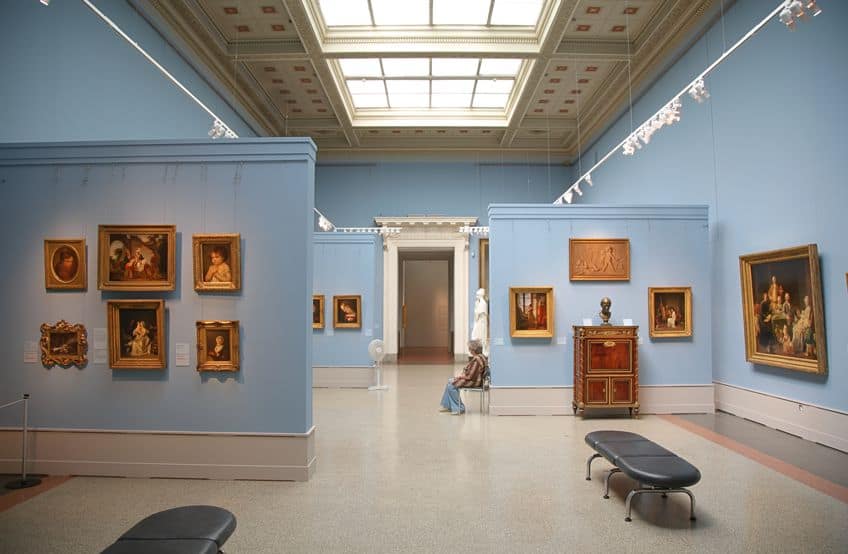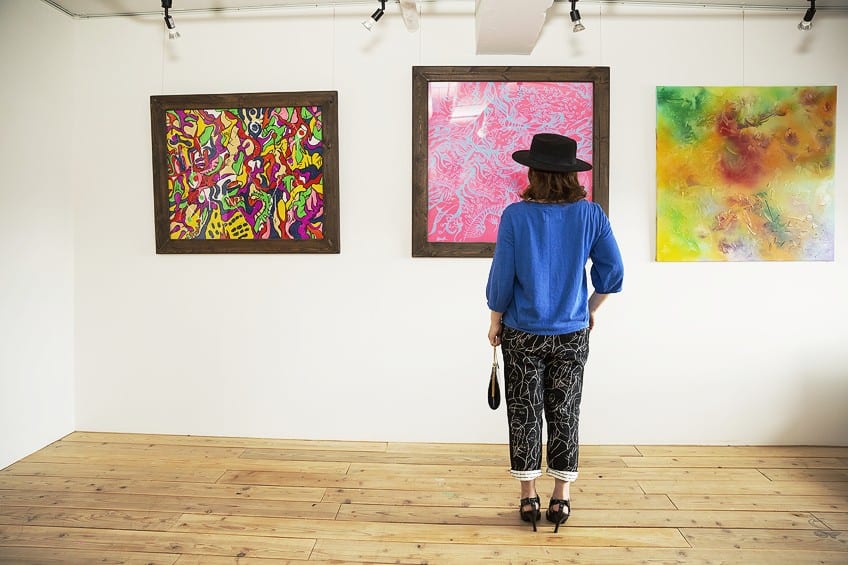What Is an Art Gallery? – Venues for Viewing and Buying Art
What is an art gallery and what is the difference between a gallery and a museum? In this article, we will be discussing the various types of art galleries, and finding out the answers to questions such as “how do art galleries work and how do art galleries make money?”. If you are an artist interested in commercial art galleries and wondering how to get into an art gallery yourself, this is the article for you!
What Is an Art Gallery?
An art gallery is a venue where people may view and purchase artworks by up-and-coming artists, as well as renowned artists. It’s vital to remember that a gallery isn’t just an ordinary store, but rather a gathering place for art enthusiasts and artists. There are various types of art galleries, such as physical galleries, which hold exhibits in a real venue, and virtual galleries, which hold exhibitions online. One may learn how to become a collector and how to keep good care of your artwork in either of these two sorts of galleries. The gallery personnel should be ready to respond to inquiries regarding the artwork’s technique, style, and quality.
What Is the Difference Between a Gallery and a Museum of Art?
Art museums and galleries are both excellent venues to see great artwork. If you’re a novice art consumer, you might think that art museums and galleries are the same thing. These institutions do have distinct functions within the art world, though. The distinction between an art museum and a gallery is becoming more blurry. The focus of many museums is on objects or exhibitions rather than on exhibiting and selling pieces of art.
A museum is not synonymous with a gallery, even if it is a specialized art museum like the Louvre or Tate Museums. Both museums and galleries will concentrate on art exhibitions, whether they are in a real place or online. Both of them have public exhibitions where pieces of art are on display. The audience can concentrate on experiencing and appreciating the visual features of original art shows since these large areas eliminate distractions. However, the parallels between art museums and galleries typically end there.
Art galleries and museums have quite diverse business approaches for funding and making money. The biggest difference between the two is that a museum is a venue for entertainment and education. The items on display at a museum are not for sale (except for those found in the obligatory gift shop perhaps). An art gallery, on the other hand, is a company that shows and sells things as well as entertains. An art gallery’s goal is to increase the visibility of the creators who display in its facilities and, eventually, to sell the works. An art museum’s objective is to exhibit a variety of works with the general population.
Art Museums
Museums are concerned with public awareness and education, thus they frequently get government financing to assist them in making the artworks more easily accessible to the general public. An art museum will typically have a fixed private collection of works that they have acquired or been given that will be on display for an extended period of time. An art museum may also show artworks on loan from other institutions or individuals. These pieces of art are typically part of short-term displays that change many times a year. Museums often exhibit renowned artworks with significant cultural importance.
These are often older or historical works of art. It is uncommon for museums to exhibit works by contemporary active artists. For the aim of art instruction, a museum curator will design displays that emphasize a specific period of painting or an artistic movement. These displays will often feature works by several artists, with the curator selecting which pieces to include. Additionally, the curator will include remarks or educational materials about the show to aid in visitors’ understanding of the exhibit’s value in terms of both history and culture.
Some art museums may concentrate on works in a particular genre or era. To demonstrate a diversity of eras and styles, many art museums, though, change their exhibits. Famous works of art are frequently lent to other museums all around the world, allowing museums to switch up their exhibitions and share them. Art museums are generally supported by bequests, donations, governmental financing, and the sale of exhibition tickets since they place a strong emphasis on education and entertainment.
Art Galleries
If art museums are funded, how do art galleries make money through art? The principal function of an art gallery is to exhibit artworks for the purpose of being sold. Of course, you may still appreciate art without purchasing it by visiting several art galleries. Yet, unlike at a museum, the artwork on exhibit in a gallery can be purchased. The money earned by a gallery from the sale of art is utilized to run the gallery. Art galleries can be small or large enterprises with locations all over the world. Some galleries comprise a simple solitary exhibition room, whereas others are the same size as an art museum.
Museums are often concentrated in major cities, however, there are literally thousands of art galleries both online and around the globe. These galleries may exhibit work by famous artists, but they may also exhibit work by modern developing artists. The fundamental purpose of an art gallery is to market art and establish partnerships with art collectors and investors. An art gallery company has a commercial environment rather than an instructive ambiance.
However, the curators and personnel of commercial art galleries are typically as educated about art as their museum counterparts. A gallery curator may assist you in choosing art for your collection as well as guide you through the full art purchase process, from artwork selection to shipment and even hanging your pieces of art. Galleries may specialize in a certain area of the art world, such as sculpture, photography, or mixed-media art. They may be specialists in selling items from a particular age or genre, such as modernist art or antiques. Both can have solo or group shows, however, a gallery will often focus on a certain specialty, whereas museums will frequently cycle the genres and styles on display.
The Various Types of Art Galleries
An art gallery is a place where artworks are shown and sold. The art gallery is a for-profit organization with a roster of artists. The gallery operates as a retailer, promoting, sponsoring, and distributing the artworks. Yet, we must keep in mind that not all art galleries are the same. Although most art galleries follow a similar strategy and organization, there are certain art galleries that follow a distinct procedure. In this situation, we will have to address each category separately, providing a detailed description of what an art gallery is and how it might show itself. Here are a few of the various types of art galleries.
Commercial Art Galleries
Commercial art galleries are the most prevalent sort of art gallery. Although the term “commercial” may carry a bad connotation, as if they are simply interested in making money, this is the “best” sort of art gallery for collectors and artists, playing an important part in the art world. The gallery partners with various artists in commercial art galleries, agreeing to represent and promote them. This indicates that the gallery has agreed to display, promote, sell, and distribute the artist’s work. Many commercial galleries now also operate in a hybrid format where they sell works online, while also arranging exhibitions in dedicated gallery spaces or at art fairs.
As a result, the artist may earn a livelihood while also expanding his profession, collector base, and artist credentials. In exchange, the gallery receives a percentage of artwork sales. As a result, the gallery is compelled to provide the best possible job for the artists, advancing their reputation and sales. It’s a win-win situation! The gallery and the artist both gain money. The better the artists’ careers are pushed and developed, the greater the gallery’s reputation. In the end, what is beneficial to the artists is beneficial to the gallery.
Vanity Art Galleries
Artists are charged by vanity art galleries to show and promote their work. Although this may appear enticing to artists just starting out, artists are advised not to engage with vanity galleries. Vanity galleries seldom have a high name in the art world, as well as a good clientele or a stable collecting base. As a result, they choose creators according to the size of their wallets rather than the quality of their artwork. Most of the time, they would showcase anybody and everything willing to pay for the show. As a result, finding really intriguing or upcoming artists at vanity galleries is unlikely.
Exhibition Spaces
In this situation, the artist leases an exhibition space in which to stage their show. The artist rents a space per day or week and is responsible for all parts of the exhibition, including supervision, marketing, print work, invites, and so on. These venues are frequently referred to as art galleries; however, because there is no curated art program and no gallerist, they are just rental rooms suitable for holding art exhibitions. As a result, they enable amateur or starting artists to present their work and get exhibition experience.
Galleries Run by Artists
We have witnessed several success stories of artist-run galleries over the last few decades. In this situation, artist collectives establish their own gallery or exhibition. The most prevalent reason for doing so is a lack of exhibition chances, so they decide to develop their own platform. These efforts need bravery to carry out; they are frequently frowned upon. Yet, an artist-run art gallery may be just as profitable and well-known as a commercial art gallery. If the artist-run gallery does well, it will gradually but steadily evolve into a commercial art gallery in order to expand its activities.
Art galleries play an important part in the art world. They serve as a vital bridge between collectors and artists, looking for emerging talent and showcasing the greatest artists through their exhibition program. However, while art galleries are important in the art world, there are numerous misunderstandings about them. In truth, what art galleries are and what they do are not generally recognized.
Frequently Asked Questions
What Is an Art Gallery?
An art gallery can be defined as a place where artworks, such as paintings and sculptures, are exhibited to the public with the aim of being sold. The art gallery is a commercial organization with either a permanent roster of various artists, or periodic temporary displays. The gallery helps the artist by offering to sell and promote the artists and their works. Not all art galleries function in the same manner, though. Although most art galleries follow a similar overarching approach to their business model, there are certain types of art galleries that follow a distinct approach.
How Do Art Galleries Work?
The art gallery creates an exhibition program that will serve as the foundation of the gallery’s image. In order to do so, the art gallery must supply gallery space. Galleries frequently rent commercial facilities with huge windows in major cities, particularly near other galleries, in order to have high visibility to a large number of potential clients. Furthermore, the gallery meticulously curates its program, seeking the most intriguing new or renowned artists, and inviting them to participate in an exhibition with the gallery. The gallery handles transport, security, monitoring, assembly, print work, press attention, invites, and exhibition launch and marketing.
How Do Art Galleries Make Money?
The working connection between gallerists and artists varies depending on the specific artist and gallery. Nevertheless, there are certain unwritten basic rules and norms. Profits from sales are divided on a regular basis at a 50-50% split of the total revenue. This implies that the materials are not subtracted from the overall turnover, unlike in other structures where some expenditures are deducted from the total turnover.
How Do I Get My Artwork Exhibited in Art Galleries?
Many young artists want to know how to get into an art gallery. Luckily, it has never been easier for artists to do so. There are many online galleries that can easily be joined. Another option is that you can approach a local art gallery in person with a portfolio of your works.
Liam Davis is an experienced art historian with demonstrated experience in the industry. After graduating from the Academy of Art History with a bachelor’s degree, Liam worked for many years as a copywriter for various art magazines and online art galleries. He also worked as an art curator for an art gallery in Illinois before working now as editor-in-chief for artfilemagazine.com. Liam’s passion is, aside from sculptures from the Roman and Greek periods, cave paintings, and neolithic art.
Learn more about Liam Davis and about us.
Cite this Article
Liam, Davis, “What Is an Art Gallery? – Venues for Viewing and Buying Art.” artfilemagazine – Your Online Art Source. May 16, 2023. URL: https://artfilemagazine.com/what-is-an-art-gallery/
Davis, L. (2023, 16 May). What Is an Art Gallery? – Venues for Viewing and Buying Art. artfilemagazine – Your Online Art Source. https://artfilemagazine.com/what-is-an-art-gallery/
Davis, Liam. “What Is an Art Gallery? – Venues for Viewing and Buying Art.” artfilemagazine – Your Online Art Source, May 16, 2023. https://artfilemagazine.com/what-is-an-art-gallery/.












